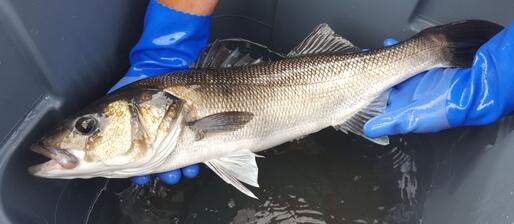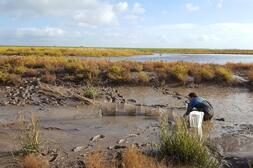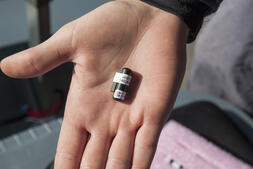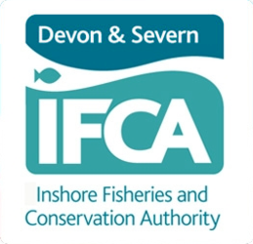European Seabass
- Home
- Environment & Research
- Research
- Finfish Research
- European Seabass
Page review/updated 04/12/2024
(Content of page last updated: 11th October 2021)
EUROPEAN SEABASS (DICENTRARCHUS LABRAX)

European seabass (bass) are demersal fish found around the UK coast, including areas from 100m depth to coastal waters and estuaries. Some areas of inshore water, in which juvenile bass are more common (and more vulnerable to fishing pressure), have been designated under national legislation – the Bass (Specified Areas) (Prohibition of Fishing) (Variation) Order 1999 – as Bass Nursery Areas (BNAs). In these areas, fishing for bass is tightly controlled during certain times of year. There are eight BNAs within the Devon and Severn IFCA’s District. Protecting young bass in these areas gives them a better chance of growing to a catchable size, and maintaining the overall stock.
Throughout Northwest Europe, bass is an important fish species to both commercial fishermen and recreational anglers. However, this species is vulnerable to overfishing, in part because it schools at inshore and offshore sites (making it easy to target large numbers at once) and it has temperature-sensitive recruitment (meaning that population growth depends on having the right environmental conditions). Bass also have a slow growth rate (meaning that populations may take a long time to recover from fishing pressure): it can take 7 years for bass to reach the minimum conservation reference size (landable size). Coupled with greatly increased market demand, the natural and human-induced pressures on European sea bass recently led to a major decline in abundance, leaving stocks at a potentially critical level.
It is therefore important to understand the biology of bass, and the pressures they face, in order to achieve sustainable fishing and get the highest economic, environmental and social benefit from the stock. This page reviews some of the important bass-related research and stakeholder engagement that is being undertaken in the UK, which aims to deliver new knowledge to achieve bass conservation and viable, sustainable fishing. It is hoped that sustainable bass fishing will be achieved through the management measures which are in place for bass fisheries; these are reviewed on our Bass Compliance Direction webpage.
BASS RESEARCH AT DEVON AND SEVERN IFCA

D&S IFCA, in collaboration with the University of Plymouth, has co-funded and co-supervised a PhD student to investigate the feasibility of localised management/conservation policies to improve local European bass populations.
The PhD project was broadly focussed on identifying movement, feeding and growth within estuarine habitats, with a particular emphasis on measuring the effectiveness of designated Bass Nursery Areas within the D&S IFCA’s District.
The research includes:
- Measuring fish ecology, feeding and growth rates within Managed Re-alignment schemes relative to surrounding established saltmarsh. Bass are the main focus of this work, but other common species (e.g. thinlip grey mullet or gobies) will also be included to identify how the novel habitats within managed re-alignment schemes are used by estuarine fish communities.
- Assessing European bass movement within designated Bass Nursery Areas (BNAs), via the deployment of a large scale acoustic telemetry array (funded through the European Maritime and Fisheries Fund). This telemetry array consists of strategically-deployed ‘receiver’ devices capable of detecting transmissions from electronic tags.

Fish caught within the Dart estuary, Salcombe Harbour and the Taw/Torridge estuaries were implanted with these electronic tags, making it possible to detect the fish and their movements. Whenever each tagged fish is within range of a receiver, the receiver records the time, date, and identity of the fish. These data have highlighted that European bass are highly resident, but often move into the open coast and between adjacent BNAs. When occupying coastal areas, bass activity is focussed in particular areas and/or in association with particular habitats. See here for more information.
The results from the acoustic telemetry survey will primarily be used to understand bass residency of nursery areas, describe how bass use coastal areas (such as estuaries and rias), assess their habitat use, and ultimately evaluate the effectiveness of spatial management such as BNAs for this species. Results from the project are regularly updated on the project website – https://sheehanresearchgroup.com/i-bass/, and will be published in peer-reviewed journals. The most recent publication is available here.
D&S IFCA’s Officers have also contributed to national-scale bass research programmes: C‑BASS and Sea Bass Fisheries Conservation UK. These projects involved novel research on the movements of bass, as well as engagement with fishers, scientists and regulators. The projects aimed to develop a better understanding of bass movements and bass fisheries, including in the South West, and to promote long-term sustainable bass fisheries in the UK. Both projects recently drew to a close, and updates will be shared when they become available.
FISHERIES RESEARCH AND MANAGEMENT PLAN FOR BASS
D&S IFCA has developed Fisheries Research and Management Plans (FRMPs), including one specifically for bass in the north of D&S IFCA’s District. The bass FRMP aims to bridge the gap between current, species-focused fisheries management and a more ecosystem-based approach at an appropriate scale. It provides an ecosystem-based review of the ecology, fisheries and management for bass, initially within the North Devon Marine Pioneer area. This approach will integrate local and historical knowledge with scientific research outcomes, building the knowledge base for sustainable ecosystem-based management at an appropriate spatial scale, and highlighting current knowledge gaps to inform future research. D&S IFCA is also currently developing an equivalent FRMP for bass in the south of the District.
